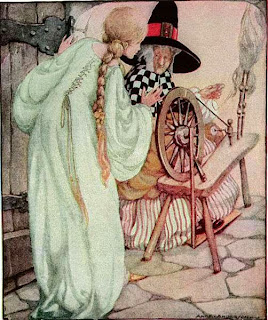Most of us have grown up surrounded by Fairy tales - stories about good fairies, bad fairies, blue fairies, tooth fairies, fairy godmothers, and some with actual names, like Tinkerbelle. These elusive little creatures flit in and out of our lives in stories populated with all manner of fascinating creatures. Dwarves, elves, giants, and mischievous little pixies are a few I remember from childhood stories. All these beloved characters have their roots in the same ancient culture, and take part in preserving the records of its history.
Once upon a time, long, long ago in northern Europe there was a time-of-little-sun. For a thousand years it was mostly overcast, the precious sun peeping through just enough to sustain life. This lack of sun along with human biology, was responsible for the emergence of those who became known as Fairies. The sun provides warmth, but also vitamin D, which, among other things, prevents rickets. Dark pigmentation limits the intake of vitamin D, preventing overdoses. The lighter the skin, the more vitamin D is able to be absorbed. The people living in northern Europe during the time-of-little-sun would have produced lighter and lighter skinned offspring; those with darker skin, suffering from rickets, would not have lived long. These fair, almost white-skinned people were descended from the Maglamosians (ca. 7000 BC), and were referred to as the “Fair Folk”, and later, “Fairies”. They are the subject of stories such as Snow White, Snow Drop, and Rose Red.
The Fair Folk practiced oral tradition just as their ancestors had for thousands of years, and according to the translations by Duncan-Enzmann these records were produced mostly by women. They passed on their history and knowledge in stories accompanied by images. These “bedtime stories” survived suppression and destruction by enemies, and the natural loss of information over time. We have inherited these records as Fairy tales, compiled and retold by Grimm, Anderson, and numerous other sources.
It is said the Fair Folk dwelt underground, in “fairy mounds,” remnants of which can still be seen today. During the time-of-little-sun the weather was cool and damp. Peat grows fast in that environment, and did. It covered the hills, and then it grew over the homes sheltered by the hills. Peat is good insulation and these homes were cozy-warm. Villages looked as if they were underground, as did the people who lived in them. Fairy mounds still dot the landscape in Ireland, evidence of ancient Fairy villages.
The skill of the astronomers, medicine ladies, Norns, and builders of the Maglemosian people was well known; feared by some, sought out by others. The Faerie culture of Tuatha de D’nan - people of the goddess D’nan (goddess of the river) – inherited this knowledge. As tribes of Celts moved and migrated, merging European cultures shared knowledge and ways of life. Stories of elves, dwarves, giants (Æsir), watchers (Vanir), pixies (Picts), leprechauns, ogres, and many other strange characters have their beginnings with these peat-covered people.
The Fair Folk were descendants of the Vanir and Æsir, and were taught astronomy and natural sciences from childhood. Their knowledge of agriculture and navigation positioned them well; they were wise, and socially powerful. Because their knowledge was extraordinary the Fair Folk gained the reputation of having magical powers, and were both feared and loved. They became great leaders to whom others looked for help surviving. This positioned them later as queens and kings, developing great monarh families which still survive today.
Centuries passed and legends of these fair-skinned, underground dwellers with magical powers resonated through history. They were immortalized in stories and legends of powerful Fairy queens and kings holding council on Fairy rings of mushrooms, raising their families in Fairy mounds. We have inherited these wondrous tales of Once Upon A Time, and, if we know how to see it, the history of a civilization that lasted thousands of years - one that still has descendants today.
 |
| Briar Rose - A. Anderson |
About Symbologist Michelle Snyder
Michelle earned her post-graduate degree at the University of Wales, decoding prehistoric images, mythology, folklore, and fairy tales and tracing them to their roots. She is an author, columnist, publisher, artist, and teacher. Her artwork, inspired by her love of symbolism and folklore, has appeared in galleries from Massachusetts to California. Michelle is co-owner of White Knight Studio.
Symbology ReVision: Unlocking Secret Knowledge
Symbology: Hidden in Plain Sight
Symbology: My Art and Symbols
Symbology: Fairy Tales Uncovered
Symbology: Decoding Classic Images
Symbology: World of Symbols
Symbology: Secrets of the Mermaids
Fiction:
A Tale of Three Kingdoms: Book One - The Lost Unicorn
A Tale of Three Kingdoms: Book Two - The Lost Mermaid
The Fairy Tales: Once-Upon-A-Time Lessons First Book










No comments:
Post a Comment